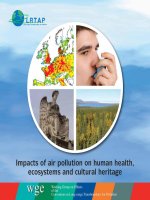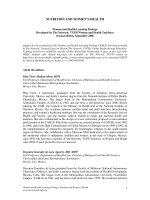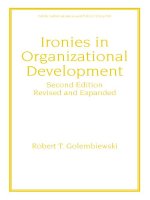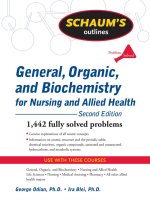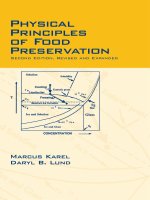SECOND EDITION Toxicology and Environmental Hazards HUMAN HEALTH Ecosystems docx
Bạn đang xem bản rút gọn của tài liệu. Xem và tải ngay bản đầy đủ của tài liệu tại đây (4.19 MB, 354 trang )
SECOND EDITION
Toxicology and Environmental Hazards
HUMAN
HEALTH
Ecosystems
and
L1568_ FM_fm Page 2 Thursday, May 10, 2001 4:00 PM
LEWIS PUBLISHERS
Boca Raton London New York Washington, D.C.
SECOND EDITION
Toxicology and Environmental Hazards
RICHARD B. PHILP
HUMAN
HEALTH
Ecosystems
and
This book contains information obtained from authentic and highly regarded sources. Reprinted material
is quoted with permission, and sources are indicated. A wide variety of references are listed. Reasonable
efforts have been made to publish reliable data and information, but the author and the publisher cannot
assume responsibility for the validity of all materials or for the consequences of their use.
Neither this book nor any part may be reproduced or transmitted in any form or by any means, electronic
or mechanical, including photocopying, microfilming, and recording, or by any information storage or
retrieval system, without prior permission in writing from the publisher.
The consent of CRC Press LLC does not extend to copying for general distribution, for promotion, for
creating new works, or for resale. Specific permission must be obtained in writing from CRC Press LLC
for such copying.
Direct all inquiries to CRC Press LLC, 2000 N.W. Corporate Blvd., Boca Raton, Florida 33431.
Trademark Notice:
Product or corporate names may be trademarks or registered trademarks, and are
used only for identification and explanation, without intent to infringe.
Visit the CRC Press Web site at www.crcpress.com
© 2001 by CRC Press LLC
No claim to original U.S. Government works
International Standard Book Number 1-56670-568-1
Library of Congress Card Number 2001001149
Printed in the United States of America 1 2 3 4 5 6 7 8 9 0
Printed on acid-free paper
Library of Congress Cataloging-in-Publication Data
Philp, Richard B.
Ecosystems and human health : toxicology and environmental
hazards / Richard B. Philp – 2nd ed.
p. cm.
Includes bibliographical references and index.
ISBN 1-56670-568-1
1. Environmental toxicology. 2. Environmental health. I.
Title.
RA1226 .P48 2001
615.9'02 dc21 2001001149
CIP
L1568_ FM_fm Page 4 Thursday, May 10, 2001 4:00 PM
Dedication
Elizabeth, Brendan, Douglas, Danielle, William, Nathan,
Danny, Anders, Margaret, Matthew, Jemma, Lauren,
and kids everywhere. Perhaps this book will help them to look
after this place better than we did. Also for my wife Joan,
who is my calm harbor in a stormy world.
L1568_ FM_fm Page 5 Thursday, May 10, 2001 4:00 PM
L1568_ FM_fm Page 6 Thursday, May 10, 2001 4:00 PM
Foreword
There is a commonly held myth in our society that anything that is “natural”
is good, wholesome, and healthful, whereas anything that is “synthetic” is
bad, toxic, and harmful. The mere mention of the word
chemical
is enough
to strike terror into the heart of any food faddist. This attitude is, at best,
naïve and, at worst, dangerous. Toxic substances abound in nature, ranging
from inorganic heavy metals such as arsenic and mercury, through organic
substances such as hydrocyanic acid, to complex enzymes and other proteins
of the neurotoxins and coagulant-anticoagulants present in venoms and
toxins. One of the more serious environmental hazards may be natural radon
gas, and cancer from solar radiation is a real concern.
Increasingly, it is becoming necessary for students of environmental sci-
ences to know something of toxicology and for students of toxicology to know
something of the environment. This text is designed to bridge these fields by
acquainting the student with the major environmental hazards — both man-
made and natural — and with the risks to human health that they pose. It is
designed such that topics are generally introduced in the early chapters and
covered in greater detail in subsequent ones. This is neither an environmen-
talist's handbook nor does it deal exclusively with toxicology; rather, it
attempts to strike a balance between the extremes of opinion and to indicate
where information is inconclusive. Examples of major accidental exposures
of humans to chemical toxicants are used liberally and case studies taken
from reported incidents are provided. Historical background of the develop-
ment of a class of chemicals or a particular environmental problem is often
provided in the belief that an educated student should know more than
merely the technical aspects of the field. It is hoped that this text will assist
students in acquiring the information and judgmental skills necessary to
differentiate between real and perceived risks, as well as acquaint them with
the toxicology of important chemicals in the environment. Because most
people spend 8 hours daily, 5 days weekly in the workplace, it constitutes an
important component of our environment and it will be considered as such.
Richard B. Philp, D.V.M., Ph.D.
L1568_ FM_fm Page 7 Thursday, May 10, 2001 4:00 PM
L1568_ FM_fm Page 8 Thursday, May 10, 2001 4:00 PM
About the Author
Richard B. Philp, D.V.M., Ph.D.,
is an emeritus professor and former Chair
of the Department of Pharmacology and Toxicology at the University of
Western Ontario. After graduating from the Ontario Veterinary College, he
practiced veterinary medicine in Illinois and in Ontario and also served as
a public health officer in a small Ontario town. He obtained his Ph.D. in
pharmacology from the University of Western Ontario and did postdoctoral
studies at the Royal College of Surgeons of England in London. He has
served on advisory committees to Canadian federal and provincial govern-
ments regarding the use of antibiotics in agriculture. He was Honorary
Visiting Professor in the School of Pathology, University of New South Wales,
and has authored or co-authored over 90 scientific papers, two books, and
several book chapters. His current research involves the study of pollution
along the Florida Gulf Coast and its effects on a species of marine sponge.
L1568_ FM_fm Page 9 Thursday, May 10, 2001 4:00 PM
L1568_ FM_fm Page 10 Thursday, May 10, 2001 4:00 PM
Contents
Chapter 1 Principles of pharmacology and toxicology 1
Introduction 1
Pharmacokinetics 4
Absorption 4
Distribution 5
Biotransformation 6
Elimination 10
Pharmacodynamics 12
Ligand binding and receptors 12
Biological variation and data manipulation 13
Dose response 14
Probit analysis 17
Cumulative effects 19
Factors influencing responses to xenobiotics 20
Age 20
Body composition 21
Sex 21
Genetic factors 22
Presence of pathology 24
Xenobiotic interactions 25
Some toxicological considerations 26
Acute vs. chronic toxicity 26
Acute toxicity 27
Peripheral neurotoxins 27
Central neurotoxins 27
Inhibitors of oxidative phosphorylation 27
Uncoupling agents 28
Inhibitors of intermediary metabolism 28
Chronic toxicity 28
Mutagenesis and carcinogenesis 29
Sites of intracellular damage 29
DNA repair 32
Genetic predisposition to cancer 33
Epigenetic mechanisms of carcinogenesis 33
L1568_ FM_fm Page 11 Thursday, May 10, 2001 4:00 PM
The role of cell repair and regeneration in toxic reactions 34
Response of tissues to chemical insult 35
Fetal toxicology 35
Teratogenesis 35
Transplacental carcinogenesis 37
Further reading 38
Review questions 39
Answers 42
Chapter 2 Risk analysis and public perceptions of risk 45
Introduction 45
Assessment of toxicity vs. risk 45
Predicting risk: workplace vs. the environment 46
Acute exposures 46
Chronic exposures 46
Very low-level, long-term exposures 46
Carcinogenesis 47
Risk assessment and carcinogenesis 47
Sources of error in predicting cancer risks 50
Portal-of-entry effects 50
Age effects 52
Exposure to co-carcinogens and promoters 52
Species differences 52
Extrapolation of animal data to humans 54
Hormesis 54
Natural vs. anthropogenic carcinogens 55
Reliability of tests of carcinogenesis 55
Environmental monitoring 56
Setting safe limits in the workplace 57
Environmental risks: problems with assessment
and public perceptions 59
The psychological impact of potential environmental risks 60
Voluntary risk acceptance vs. imposed risks 60
Costs of risk avoidance 61
Some examples of major industrial accidents and environmental
chemical exposures with human health implications 62
Radiation 62
Formaldehyde 62
Dioxin (TCDD) 63
Some legal aspects of risk 64
De minimis concept 64
Delaney Amendment 64
Statistical problems with risk assessment 65
Risk management 66
L1568_ FM_fm Page 12 Thursday, May 10, 2001 4:00 PM
The precautionary principle 67
Further reading 68
Review questions 69
Answers 71
Case study 1 71
Case study 2 72
Chapter 3 Water and soil pollution 73
Introduction 73
Factors affecting toxicants in water 74
Exchange of toxicants in an ecosystem 74
Factors (modifiers) affecting uptake of toxicants from
the environment 74
Abiotic modifiers 76
Biotic modifiers 77
Some important definitions 78
Toxicity testing in marine and aquatic species 79
Water quality 79
Sources of pollution 80
Some major water pollutants 81
Chemical classification of pesticides 82
Health hazards of pesticides and related chemicals 83
Chlorinated hydrocarbons 83
Chlorphenoxy acid herbicides 83
Organophosphates (organophosphorus insecticides) 84
Carbamates 84
Acidity and toxic metals 84
Chemical hazards from waste disposal 86
The Love Canal story 87
Problems with Love Canal studies 89
Toxicants in the Great Lakes: implications for human health
and wildlife 90
Evidence of adverse effects on human health 91
Evidence of adverse effects on wildlife 93
Global warming and water levels in the Great Lakes 93
The marine environment 93
Aquatic toxicology 94
Biological hazards in drinking water 95
Anatomy of a small town disaster 96
Further reading 98
Review questions 100
Answers 102
Chapter 4 Airborne hazards 103
Introduction 103
L1568_ FM_fm Page 13 Thursday, May 10, 2001 4:00 PM
Types of air pollution 103
Gaseous pollutants 103
Particulates 104
Smog 104
Sources of air pollution 104
Atmospheric distribution of pollutants 105
Movement in the troposphere 105
Movement in the stratosphere 106
Water and soil transport of air pollutants 106
Types of pollutants 106
Gaseous pollutants 106
Particulate pollutants 107
Health effects of air pollution 107
Acute effects 107
Chronic effects 108
Air pollution in the workplace 108
Asbestos 108
Silicosis 109
Pyrolysis of plastics 109
Dust 110
CO and NO
2
110
Multiple chemical sensitivity 111
Chemical impact of pollutants on the environment 114
Sulfur dioxide and acid rain 114
The chemistry of ozone 115
Chlorine 116
Global warming 116
Water 116
Carbon dioxide 117
Methane 118
Subtle greenhouse effects 119
Global cooling: new Ice Age? 119
Sulfur dioxide 120
Motor vehicle exhaust 120
Natural factors and climate change 121
Remedies 122
Further reading 123
Review questions 124
Answers 126
Case study 3 126
Case study 4 127
Case study 5 127
Case study 6 127
Case study 7 128
Case study 8 128
L1568_ FM_fm Page 14 Thursday, May 10, 2001 4:00 PM
Chapter 5 Halogenated hydrocarbons and halogenated aromatic
hydrocarbons 129
Introduction 129
Early examples of toxicity from halogenated hydrocarbons 129
Physicochemical characteristics and classes of halogenated
hydrocarbons 130
Antibacterial disinfectants 130
Herbicides 131
Dioxin (TCDD) toxicity 131
Hepatotoxicity 132
Porphyria 132
Chloracne 132
Cardiovascular effects 133
Carcinogenicity 133
Neurotoxicity 135
Reproductive toxicity 135
Metabolic disturbances 135
The role of the aryl hydrocarbon receptor (AhR)
and enzyme induction 135
Paraquat toxicity 137
Insecticides 137
Industrial and commercial chemicals 138
Biphenyls 138
Toxicity 138
Pharmacokinetics and metabolism 139
Biodegradation 139
Accidental human exposures 139
The problem of disposal 140
Solvents 140
Toxicity 140
Mechanism of toxicity 141
Trihalomethanes (THMs) 141
Further reading 142
Review questions 143
Answers 145
Case study 9 145
Case study 10 146
Chapter 6 Toxicity of metals 147
Introduction 147
Lead (Pb) 148
Toxicokinetics of lead 149
Cellular toxicity of lead 149
Fetal toxicity 150
Treatment 150
L1568_ FM_fm Page 15 Thursday, May 10, 2001 4:00 PM
Mercury (Hg) 151
Elemental mercury toxicity 152
Inorganic mercurial salts 152
Organic mercurials 152
Mechanism of mercury toxicity 153
Treatment of mercury poisoning 153
The Grassy Narrows story 154
Cadmium (Cd) 155
Cadmium toxicokinetics 156
Cadmium toxicity 156
Treatment 157
Arsenic (As) 157
Toxicokinetics of arsenicals 157
Toxicity 158
Treatment 158
Environmental effects of arsenic 158
Chromium (Cr) 158
Other metals 159
Metallothioneins 160
Carcinogenicity of metals 160
Unusual sources of heavy metal exposure 161
Further reading 161
Review questions 162
Answers 164
Case study 11 164
Case study 12 165
Case study 13 165
Chapter 7 Organic solvents and related chemicals 167
Introduction 167
Classes of solvents 168
Aliphatic hydrocarbons 168
Halogenated aliphatic hydrocarbons 168
Aliphatic alcohols 169
Glycols and glycol ethers 171
Aromatic hydrocarbons 171
Solvent-related cancer in the workplace 172
Benzene 172
Bis(chloromethyl) ether (BCME) 173
Dimethylformamide (DMF) and glycol ethers 174
Ethylene oxide (CH
2
CH
2
O) 174
Factors influencing the risk of a toxic reaction 175
Non-occupational exposures to solvents 175
Further reading 175
Review questions 176
L1568_ FM_fm Page 16 Thursday, May 10, 2001 4:00 PM
Answers 177
Case study 14 177
Case studies 15 and 16 178
Case study 15 178
Case study 16 178
Chapter 8 Food additives, drug residues and other food toxicants 179
Food additives 179
Food and drug regulations 179
Some types of food additives 180
Artificial food colors 182
Emulsifiers 184
Preservatives and anti-oxidants 184
Artificial sweeteners 185
Flavor enhancers 187
Drug residues 187
Antibiotics and drug resistance 188
Infectious drug resistance (IDR) 189
Infectious diseases 193
Allergy 193
Diethylstilbestrol 193
Bovine growth hormone 196
Natural toxicants and carcinogens in human foods 197
Some natural toxicants 198
Favism 198
Toxic oil syndrome 198
Herbal remedies 199
Natural carcinogens in foods 200
Bracken fern “fiddleheads” 200
Others 200
Further reading 201
Review questions 203
Answers 205
Case study 17 206
Chapter 9 Pesticides 207
Introduction 207
Classes of insecticides 209
Organochlorines (chlorinated hydrocarbons) 209
Organophosphorus insecticides 211
Carbamate insecticides 212
Botanical insecticides 213
Herbicides 213
Chlorphenoxy compounds 213
Dinitrophenols 213
L1568_ FM_fm Page 17 Thursday, May 10, 2001 4:00 PM
Bipyridyls 214
Carbamate herbicides 215
Triazines 215
Fungicides 215
Dicarboximides 215
Newer biological control methods 216
Government regulation of pesticides 216
Problems associated with pesticides 217
Development of resistance 217
Multiple resistance 217
Nonspecificity 218
Environmental contamination 218
Balancing the risks and the benefits 218
Toxicity of pesticides for humans 219
Further reading 220
Review questions 221
Answers 222
Case study 18 222
Case study 19 223
Chapter 10 Mycotoxins and other toxins from unicellular organisms 225
Introduction 225
Some human health problems due to mycotoxins 225
Ergotism 225
Aleukia 227
Aflatoxins 227
Fumonisins 228
Other mycotoxic hazards to human health 230
Economic impact of mycotoxins 230
Fusarium life cycle 231
Trichothecenes 231
Zearalonone 231
Vomitoxin (deoxynivalenol or DON) 231
Species differences in DON toxicokinetics 231
Other trichothecenes 233
Detoxification of grains 234
Harvesting and milling 234
Chemical treatments 234
Binding Agents 234
Other techniques 234
Other toxins in unicellular members of the plant kingdom 235
Further reading 236
Review questions 236
Answers 239
L1568_ FM_fm Page 18 Thursday, May 10, 2001 4:00 PM
Chapter 11 Animal and plant poisons 241
Introduction 241
Toxic and venomous animals 242
Toxic and venomous marine animals 242
Scalefish toxins 242
Ciguatoxin 242
Tetrodotoxin 243
Scombroid poisoning 243
Icthyotoxin 244
Shellfish toxins 244
Saxitoxin 244
Domoic acid 244
Okadaic acid 244
Direct toxicity from dinoflagellates 244
Stinging fishes 245
Mollusk venoms 245
Conotoxins 245
Coelenterate toxins 246
Echinoderm venoms 246
Toxic and venomous land animals 246
Venomous snakes 246
Snake venoms 247
First aid 249
Venomous arthropods 249
Toxic plants and mushrooms 250
Vesicants 250
Cardiac glycosides 251
Astringents and gastrointestinal irritants (pyrogallol tannins) 251
Autonomic agents 251
Dissolvers of microtubules 252
Phorbol esters 252
Cyanogenic glycosides 253
Detoxification of hydrogen cyanide 253
Convulsants 254
Use in research and treatment 254
Further reading 255
Review questions 257
Answers 258
Case study 20 258
Case study 21 259
Case study 22 259
Case study 23 259
Case study 24 260
Case study 25 260
L1568_ FM_fm Page 19 Thursday, May 10, 2001 4:00 PM
Chapter 12 Environmental hormone disrupters 261
Introduction 261
The Lake Apopka incident 262
A brief review of the physiology of estrogens and androgens 262
Mechanisms of hormone disruption 263
Methods of testing for hormone disruption 263
Some examples of xenoestrogen interactions
with E2 receptors or effects
in vivo
or
in vitro
264
Some effects on the male reproductive system 265
Modulation of hormone activity through effects
on the Ah receptor 265
Phytoestrogens 266
Results of human studies 266
Males 266
Females 268
Effects in livestock and wildlife 270
Problems in interpreting and extrapolating results to humans 270
Further reading 271
Review questions 272
Answers 273
Chapter 13 Radiation hazards 275
Introduction 275
Sources and types of radiation 276
Sources 276
Natural sources of radiation 276
Man-made sources of radiation 276
The cause of radiation 276
Types of radioactive energy resulting from nuclear decay 277
Measurement of radiation 277
Measures of energy 277
Measures of damage 278
Major nuclear disasters of historic importance 278
Hiroshima 278
Chernobyl 279
Three Mile Island 280
The Hanford release 280
Radon gas: the natural radiation 281
Tissue sensitivity to radiation 282
Microwaves 283
Ultraviolet radiation 284
Medical uses of UV radiation 284
Extra-low-frequency (ELF) electromagnetic radiation 285
Irradiation of foodstuffs 287
L1568_ FM_fm Page 20 Thursday, May 10, 2001 4:00 PM
Further reading 288
Review questions 289
Answers 290
Chapter 14 Gaia and chaos: how things are connected 291
The Gaia hypothesis 291
Chaos theory 293
Other examples of interconnected systems 294
A vicious circle 294
Domino effects of global warming 294
A feedback loop 297
Food production and the environment 297
Meat vs. grain 297
Genetically modified plant foods 300
The environment and cancer 302
Further reading 302
Chapter 15 Case study reviews 305
Case study 1 305
Case study 2 305
Case study 3 306
Case study 4 306
Case study 5 306
Case study 6 307
Case study 7 307
Case study 8 307
Case study 9 308
Case study 10 308
Case study 11 308
Case study 12 309
Case study 13 309
Case study 14 310
Case studies 15 and 16 311
Case study 17 311
Case study 18 311
Case study 19 312
Case study 20 312
Case study 21 313
Case study 22 313
Case study 23 314
Case study 24 314
Case study 25 314
L1568_ FM_fm Page 21 Thursday, May 10, 2001 4:00 PM
L1568_ FM_fm Page 22 Thursday, May 10, 2001 4:00 PM
1
chapter one
Principles of pharmacology
and toxicology
The right dose differentiates a poison and a remedy.
— Paracelsus, 1493–1541
Introduction
The past century has seen a tremendous expansion in the number of synthetic
chemicals employed by humankind as materials, drugs, preservatives for
foods and other products, pesticides, cleaning agents, and even weapons of
war. An estimated 64,000 chemicals are currently in use commercially, with
5 billion tons being produced annually in the world. Some 4000 chemicals
are used as medicinals and at least 1200 more as household products. An
estimated 700 new chemicals are synthesized each year. Add to this the
numerous natural substances, both inorganic and organic, that possess toxic
potential, and it is little wonder that the public expresses concern and even,
sometimes, panic about the harmful effects these agents may exert on their
health and on the environment. Many of these agents, perhaps 50,000 of
them, have never been subjected to a thorough toxicity testing.
Approximately 500 chemicals have been evaluated for carcinogenic
potential. Some 44 have been designated as possible human carcinogens on
the basis of evidence, either limited or conclusive, obtained from human
studies. Of these, 37 tested positive for carcinogenicity in animal tests and
were later shown to be carcinogens for humans. There are, however, numer-
ous other agents that have been shown to be carcinogenic in rodents but
which have yet to be identified as human carcinogens. This creates signif-
icant problems regarding the legislative and regulatory decisions that need
to be made about their use. Some of the areas of uncertainty that surround
the extrapolation of data from the animal setting to the human setting are
discussed in the following chapter. The process of extrapolation requires
L1568_ch01_fm Page 1 Thursday, May 10, 2001 4:07 PM
2 Ecosystems and human health: toxicology and environmental hazards
input from many different disciplines that may include engineering, phys-
ics, biology, chemistry, pathology, pharmacology, physiology, public health,
immunology, epidemiology, biostatistics, and occupational health. The field
of toxicology thus depends on all of these, but perhaps draws most heavily
on pharmacology, biochemistry, and pathology. It is the identification of the
degree of risk to which individuals or groups are exposed in a given set of
circumstances that directs all of this activity.
Other forms of toxicity, hepatotoxicity, nephrotoxicity, and neural toxic-
ity, for example, may be more important in acute exposures such as might
occur in the industrial setting. Reproductive and fetal toxicity has been
frequently demonstrated experimentally, but their significance for the gen-
eral population exposed to low levels of toxicants in the environment
remains unclear.
The (U.S.) Agency for Toxic Substances and Disease Registry, and the
(U.S.) Environmental Protection Agency jointly maintain a priority list of 275
toxic substances. The “top 20” include arsenic, lead, metallic mercury, vinyl
chloride, benzene, polychlorinated biphenyls (PCBs), cadmium,
benzo[a]pyrene, benzo(b)fluoranthene, polycyclic aromatic hydrocarbons
(PAHs), chloroform, aroclor 1254, P
′
P
′
-DDT, aroclor 1260, trichloroethylene,
chromium(+6), and dibenz[a,h]anthracene. The complete list can be viewed
on the internet at :8080/97list.html.
Considerable difficulty attends efforts to extrapolate the results of tox-
icity tests in experimental animals to humans exposed to very low levels in
their environment, especially with regard to the risk of cancer. Current leg-
islation requires testing in two species with sufficient numbers for reliable
statistical analysis. Rats and mice are generally used, as hamsters are resistant
to many carcinogens and primates are too expensive and, in the case of some
species, too environmentally threatened. For statistical purposes, cancer
includes all tumors, whether benign or malignant. A 2-year carcinogen
study — one for analysis (pathology, etc.) and one for documentation and
statistics — employing two species cost, in 1991, at least $1,000,000 plus the
costs of 1 year for preparation. Because it is not practical to test every chem-
ical, several factors should be considered in selecting test chemicals. These
include the frequency and severity of observed effects, the extent to which
the chemical is used, its persistence in the environment (examples of persis-
tent chemicals include chlorinated hydrocarbons), and whether transforma-
tions to more toxic agents occur.
Heavy metals, the by-products of most mining and ore extraction pro-
cesses, are examples of ubiquitous toxicants with almost infinite half-lives.
Mercury (Hg), for example, is present in all canned tuna at about 5 ppm,
mostly from natural sources. Aquatic bacteria can transform mercury to
methylmercury. This has a different toxicity profile. Cadmium (Cd) enters
the environment at about 7000 tons/year and is concentrated by livestock
L1568_ch01_fm Page 2 Thursday, May 10, 2001 4:07 PM

